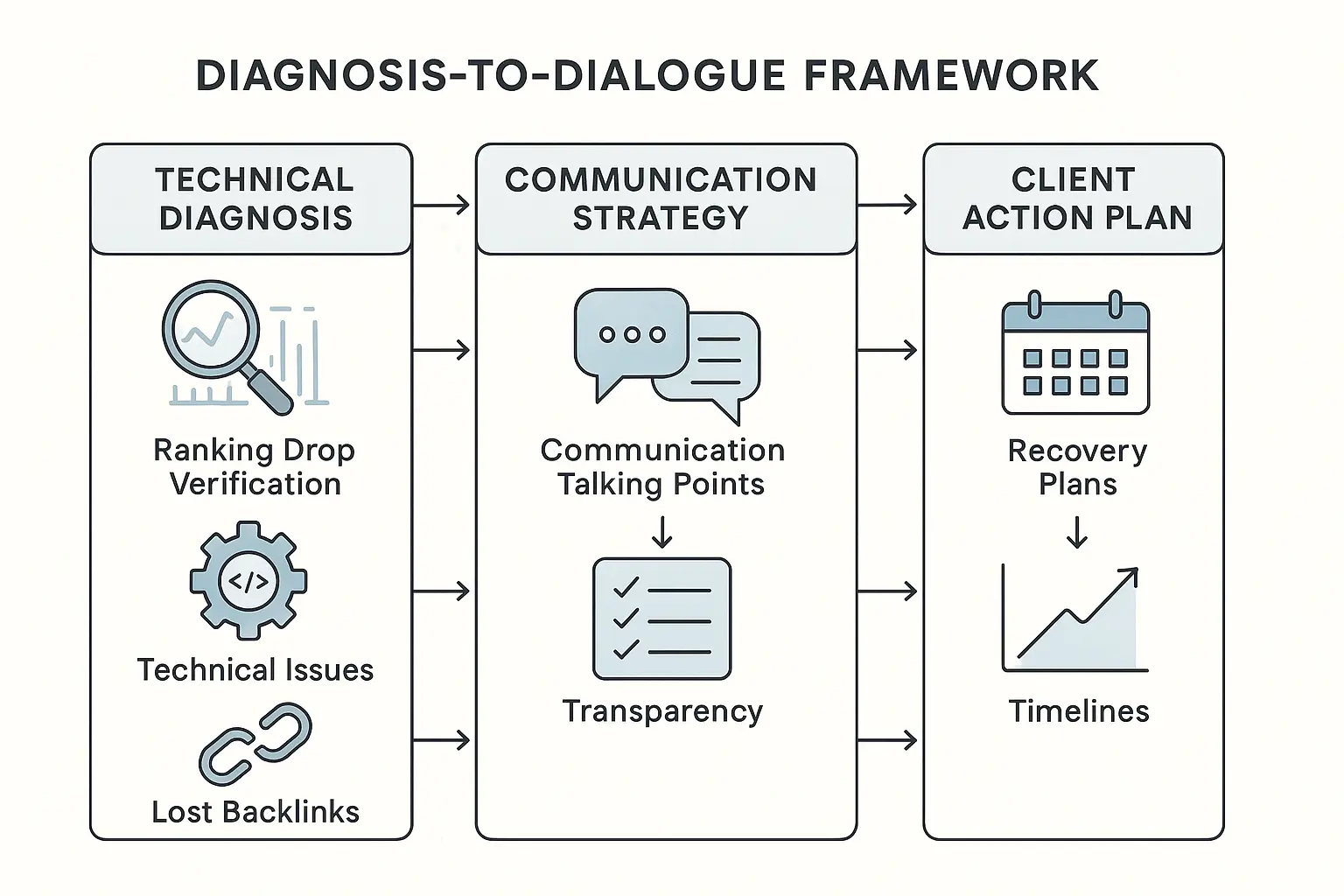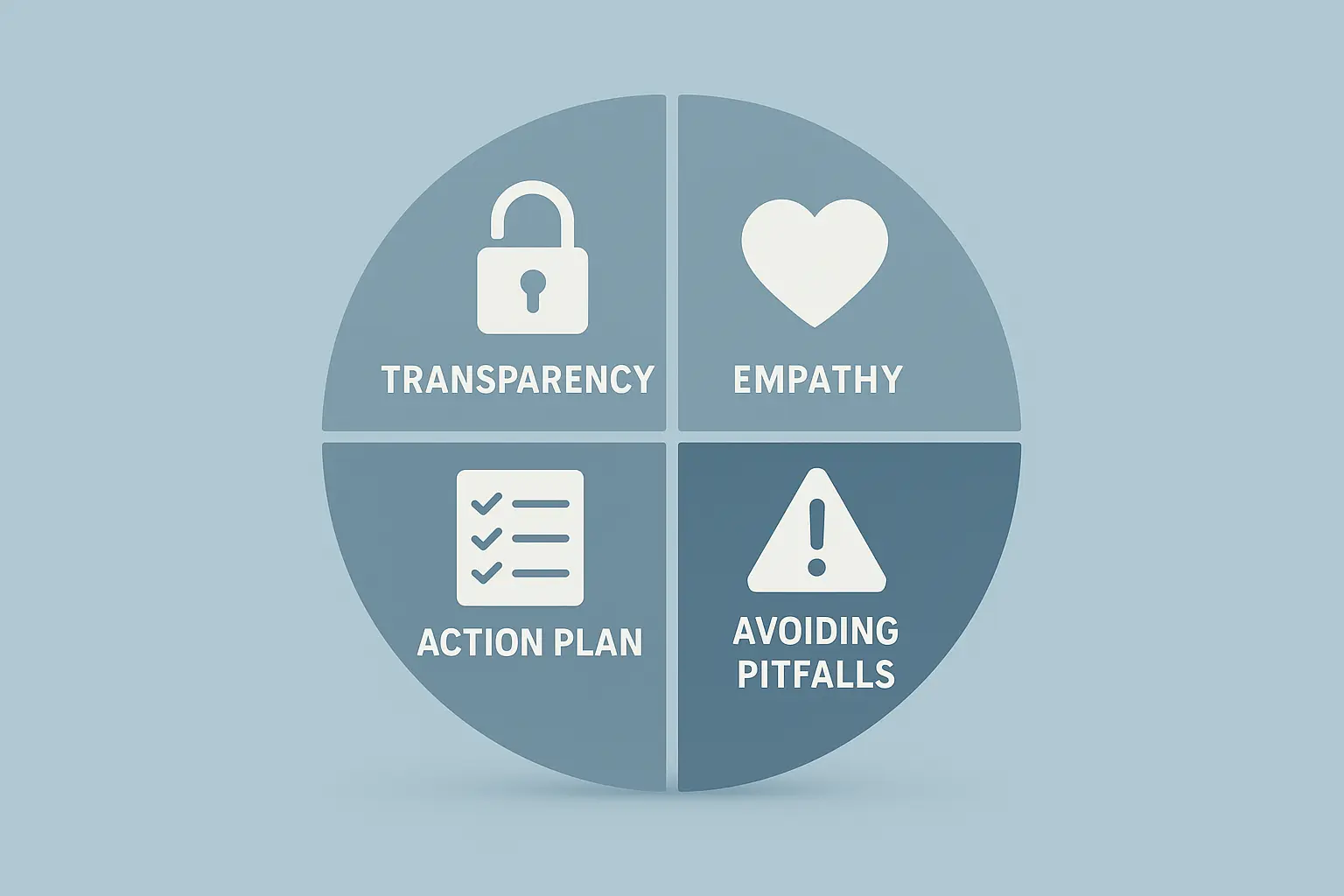We’ve all been there. You open your rank tracker a week before the monthly client report is due, and your stomach drops. A key term has fallen off page one, organic traffic has taken a nosedive, and that beautiful, upward-trending graph now has a very unwelcome valley.
How you handle this moment is what separates good agencies from great partners. The temptation is to minimize, deflect, or simply hope the client doesn’t notice. But what if this moment of bad news was actually your biggest opportunity to build unbreakable trust?
Navigating these conversations isn’t about making excuses; it’s about demonstrating expertise and control. This guide offers a framework for turning a performance dip into a powerful demonstration of your value.
Why Proactive Transparency Is Your Best Strategy
In an industry where research shows that only one in three marketers can confidently prove the ROI of their efforts, ambiguity is your enemy. When clients feel uncertain about the value you provide, any drop in performance can seem like a justification for their doubts. Hiding bad news only confirms their fears.
Proactive communication, however, flips the script. By addressing a dip before the client does, you:
-
Control the Narrative: You aren’t reacting to an accusation; you’re presenting a strategic analysis.
-
Reinforce Your Expertise: Anyone can share good news. It takes a true expert to diagnose a problem, explain complex external factors, and lay out a clear recovery plan.
-
Build Long-Term Trust: You show that your partnership isn’t just about the wins, but that you’re their guide through the inevitable challenges of the SEO landscape.
Volatility is a feature of SEO, not a bug. Your job is to be the steady hand that navigates it.
First, Diagnose the Drop: What Really Happened?
Before you can communicate the problem, you need to understand it. A drop in rankings is a symptom, not a diagnosis. Your first step is to investigate the root cause, which typically falls into one of these categories.
The Usual Suspect: Google Algorithm Updates
Google itself notes that it makes thousands of updates to its search algorithms every year. Most are minor, but a few “core updates” can significantly reshuffle the search results.
What it looks like: A sudden, sharp drop in rankings across a wide range of keywords, often coinciding with public announcements from Google or widespread chatter in the SEO community.
How to confirm: Check SEO industry news sites (like Search Engine Land) and data from rank volatility trackers (like MozCast or Semrush Sensor) for dates that line up with your drop.
The Silent Killer: Technical SEO Issues
Sometimes, the problem is closer to home. A small technical change can have a massive impact on how Google sees your client’s website.
What it looks like: Traffic drops to specific pages or sections of a site, or a sudden de-indexing of key pages.
Common culprits: An accidental noindex tag added during a site update, a robots.txt file blocking crucial crawlers, or a spike in 404 errors after a site migration. A comprehensive technical SEO audit is the only way to uncover these hidden issues.
The Shifting Battlefield: Competitor Activity
SEO is a zero-sum game. For you to move up, someone else has to move down—and the reverse is also true.
What it looks like: A gradual or sudden dip in rankings for specific, high-value keywords where one or two competitors have surged ahead.
What to investigate: Did a competitor just launch a huge content hub? Did they acquire a set of powerful backlinks from a major publication? Analyzing their recent activity can reveal the cause.
The Framework for Your Report: From Panic to Plan
Once you’ve done your homework, you’re ready to build your report. Instead of burying the bad news on slide 12, lead with it. Frame it as the central challenge you’re tackling together.
Step 1: Lead with the Data (The What)
Start with a clear, honest visualization of the performance dip. Don’t hide it—put it front and center. This shows you aren’t afraid of the data, which is crucial when 55% of marketers say their top challenge is identifying meaningful trends from their data. By presenting the situation clearly, you’re already providing value.

Step 2: Provide the Diagnosis (The Why)
This is where you connect the “what” to the “why.” Explain the root cause you uncovered in your investigation. Be sure to translate technical jargon into business impact.
Bad Example (Vague & Blaming): “Google did an update and our rankings went down.”
Good Example (Specific & Authoritative): “Our analysis shows this dip directly coincides with Google’s May Core Update, which targeted content quality and user experience signals. Sites in our industry that relied on older content formats saw similar impacts. This tells us we need to accelerate our planned content refresh initiative.”
Step 3: Present the Recovery Plan (The How)
This is the most important step. You’ve shown the problem and explained the cause; now you present the solution. Lay out a clear, actionable plan with a timeline.
Action 1: Content Alignment: “We are auditing our top 20 landing pages against Google’s new E-E-A-T (Experience, Expertise, Authoritativeness, Trustworthiness) guidelines. We will deliver updated content briefs for the first 5 pages by next Friday.”
Action 2: Technical Fortification: “We have identified and fixed the crawl error that was preventing Google from indexing our new resources section.”
Action 3: Competitive Response: “Competitor X has gained ground with their new ‘Ultimate Guide.’ We are fast-tracking the production of our own comprehensive resource, which will be more in-depth and include original data.”

For many agencies, executing a rapid recovery plan can strain resources. This is where having a reliable fulfillment partner can be a game-changer, allowing you to deploy expert white-label SEO services to accelerate a comeback without overwhelming your in-house team.
Step 4: Reiterate Long-Term Value (The Big Picture)
Finally, zoom out. Remind the client that SEO is a long-term investment, and use data to reinforce the channel’s importance. Organic search still drives over 50% of all website traffic on average, making it the most dominant channel. Short-term fluctuations are bumps in the road, not the end of the journey.
Remind them of past successes and how your strategy is designed for sustained growth, not just quick wins.
Frequently Asked Questions
Q1: How soon should I tell my client about a ranking drop?
As soon as you have a credible diagnosis and a coherent plan. Rushing to report it with no answers will only cause panic. Waiting until the client discovers it themselves will destroy trust. Find the sweet spot: investigate, plan, then report.
Q2: What if I don’t know the exact cause of the drop?
It’s better to be honest about uncertainty than to invent a false cause. You can say, “We’ve seen a dip that aligns with a potential Google update, but there’s no official confirmation yet. Our team is actively analyzing data from our tools and the wider industry to form a concrete action plan. Our initial steps will focus on strengthening technical foundations, which is best practice regardless.”
Q3: Can a single algorithm update wipe out all our progress?
It’s extremely rare for a site with strong SEO fundamentals to be permanently wiped out. Core updates are designed to reward quality. If your strategy is sound, an update may cause a temporary dip, but it often presents an opportunity to lean into best practices and come back even stronger.
Q4: Should I recommend pausing SEO services after a big drop?
Absolutely not. Pausing SEO during a dip is like taking your foot off the gas when you’re trying to go up a hill. This is precisely the time when expert analysis, strategic adjustments, and consistent execution are most critical for recovery.
Turning Setbacks into Stepping Stones
Negative SEO performance is not a question of if, but when. The strength of your agency isn’t measured by its ability to avoid downturns, but by how it responds to them.
By embracing proactive transparency and using a data-driven framework, you transform a potentially damaging event into a trust-building milestone. You prove that you’re not just a vendor who sends reports; you’re an essential partner navigating a complex digital landscape on their behalf.

Building a resilient, adaptable SEO strategy is the ultimate defense against volatility. If you’re looking to strengthen your agency’s delivery capabilities, consider exploring what an agency SEO partner can bring to your team.

